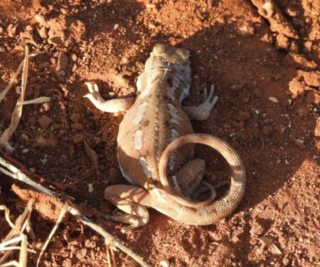
Gehyra is a genus of geckos in the family Gekkonidae. They are known as web-toed geckos or dtellas, and most species within the genus bear close resemblance to geckos from the genus Hemidactylus.

Diplodactylus is a genus of geckos of the family Diplodactylidae from Australia. They are sometimes called stone geckos or fat-tailed geckos. Member species are morphologically similar but genetically distinct.

Oedura is a genus of medium to large geckos, lizards in the family Diplodactylidae. The genus is endemic to Australia. Species in the genus are referred to by the common name velvet geckos.
The mulga dragon is a species of agamid lizard found in Western Australia. The species is up to 250 mm long, the length from snout to vent is 95 mm, with a long, slender tail that ends abruptly. The patterning over the legs and body is grey and brownish streaks. This provides an excellent camouflage on mulga trees, its usual habitat, it is also found beneath mulga leaf litter. Diporiphora amphiboluroides generally remains motionless and unobserved, this allows it to operate as an ambush predator and elude animals that would prey on it.

Ctenophorus is a genus of lizards, also known as comb-bearing dragons, that contains the most diverse group of dragon lizards in Australia. It is the largest group of Australian lizards and it has an extensive radiation in the arid zones. Many of these have been grouped by a similar morphology. The informal names and groupings within this genus — rock, crevice-, ground, sand-, and bicycle-dragon — are named after the mythological creature, the dragon.

Tympanocryptis is a genus of Australian lizards in the family Agamidae commonly known as earless dragons.

Delma is a genus of lizards in the family Pygopodidae. The genus Delma contains 22 valid described species, all of which are endemic to Australia.

Eremiascincus is a genus of skinks, lizards in the family Scincidae. The genus is endemic to Australia, Indonesia, and East Timor.

Lerista is a diverse genus of skinks endemic to Australia, commonly known as sliders. The genus is especially notable for the variation in the amount of limb reduction. The variation ranges from short-bodied forms with large legs bearing five toes, to elongate forms completely lacking legs. The body length of the lizards is 33–103 millimetres (1.3–4.1 in). Their locomotion is linked to their body shape. The shorter skinks with prominent limbs travel on the surface; the longer skinks with reduced legs tend to burrow more. A phylogenetic tree of Lerista, derived from DNA analysis, reveals that limb loss has happened multiple times within this group. Limb loss has occurred relatively recently, in the past 3.6 million years or so.

Anilios is a genus of snakes in the family Typhlopidae.

Crenadactylus, the clawless geckos, are named for their distinguishing feature, the absence of terminal claws on the digits. They are the only Australian members of Gekkonidae to lack claws, the endemic genus is also the smallest in size.

Diporiphora winneckei, also known commonly as the canegrass dragon, canegrass two-line dragon, blue-lined dragon, and Winnecke's two-pored dragon, is a species of small, terrestrial, diurnal lizard in the family Agamidae. The species is endemic to Australia. It is found throughout arid zones of Australia and is also a common house pet.

Ctenophorus parviceps, commonly known as the Gnaraloo heath dragon or northwestern heath dragon is a species of agamid lizard occurring in pale coastal sands and shell grit with open heaths and beach spinifex, between the North West Cape and Carnarvon, Western Australia and on Bernier Island. The Gnaraloo Heath Dragon is a lizard that can be found along the coast of Western Australia between Exmouth Gulf and Shark Bay, and is also known as the Northwestern Heath Dragon. It is native to Australia and usually inhabits sandy coastal dunes. The species’ longevity is 3–50 years and its population density is extremely low. The Gnaraloo Heath Dragon is a member of the Agamidae family, which contains 15 genera. The lizard is under the Ctenophorus genus which has up to 33 species. This genus shows the most morphological and ecological diversity out of the three large agamid genera. 83% of the lizards in this genus lack a crest, while 17% possess crests. They are smaller than most agamids but do have relatively large heads. The Gnaraloo Heath Dragon can be differentiated from related species by a series of spines on the tail's base, a pale-grey brown broad vertebral band along its back, and hour-glass bars extending upwards to meet the pale vertebral band. It is usually 45mm in terms of length, measuring from snout to vent.
Diporiphora albilabris, the white-lipped two-line dragon or tar tar lizard, is a species of agama found in Australia.
Diporiphora bennettii, also known commonly as the Kimberley sandstone dragon or the robust two-line dragon, is a species of lizard in the family Agamidae. The species is endemic to Australia.

Diporiphora bilineata, the northern two-line dragon or two-lined dragon, is a species of agama found in Australia and Papua New Guinea.
Diporiphora pindan, the Pindan two-line dragon or Pindan dragon, is a species of agama found in Australia.
Diporiphora valens, the southern Pilbara spinifex dragon , southern Pilbara tree dragon, or Pilbara two-line dragon, is a species of agama found in Australia.
Diporiphora vescus, the northern Pilbara tree dragon, is a species of agama found in Australia.














